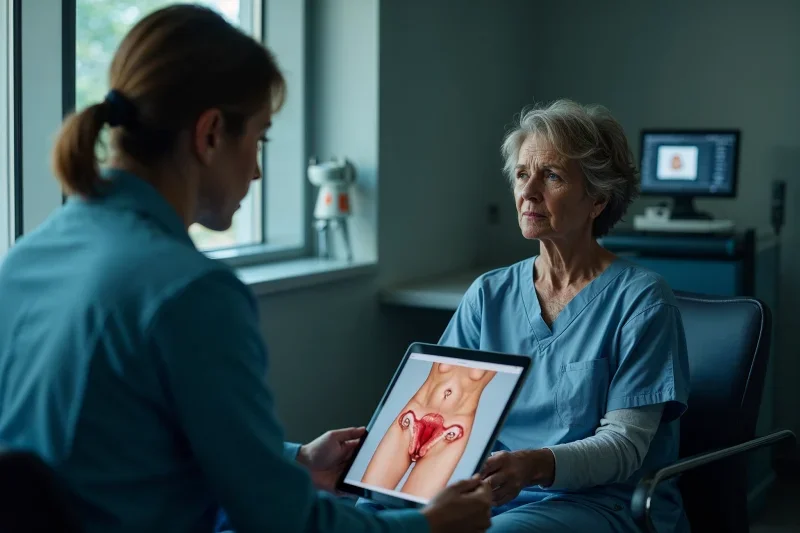What is the Difference Between Robotic Hysterectomy and Laparoscopic Hysterectomy in Burleson, TX?
Categories:
By: Ethan Cole
In the Burleson–Fort Worth area, conversations about hysterectomy rarely take long to mention the two most popular minimally invasive approaches: robotic-assisted laparoscopic hysterectomy and conventional laparoscopic hysterectomy. Both surgical methods move far beyond the large abdominal hysterectomy incisions of years past, yet subtle distinctions in the technology, surgeon ergonomics, and patient recovery can guide which route best serves you. As an obstetrician gynecologist in Burleson, Dr. Jason Neef routinely discusses how the precision and control of the da Vinci Surgical System stack up against traditional “straight-stick” laparoscopy for benign conditions such as fibroids, endometriosis, and heavy bleeding. Below, you’ll find an up-to-date comparison that integrates local hospital data, national research on surgical outcomes, and practical tips so you can choose the best surgical approach with confidence.
Key Takeaways
Robotic hysterectomy uses articulated, wristed tools controlled from a 3D console, giving the surgeon greater dexterity than conventional laparoscopic hysterectomies.
Both methods are minimally invasive procedures that rely on small incisions, resulting in fewer complications, less risk of infection, and markedly shorter hospital stays compared to open surgeries.
For complex anatomy—large uteri, dense adhesions, or multiple prior abdominal surgeries—the robotic surgical system often delivers faster recovery time and lower conversion-to-open rates.
In Burleson and the broader Worth area, average hospital stay is 24–36 hours for robotic cases versus 24–48 hours for total laparoscopic hysterectomy. Most patients return to normal activities in 1–2 weeks with robotics and 2–3 weeks with laparoscopy.
Facility fees for a robotic system can run $2,000–$4,000 higher, yet insurance plans such as Blue Cross Blue Shield of Texas frequently treat both as medically necessary if hysterectomy is the surgical removal indicated for benign disease.
Surgeon experience matters more than the machine. Look for a minimally invasive hysterectomy specialist who performs 30–50 robotic and traditional laparoscopic procedures a year.
Quick-View Comparison Table
|
Feature |
Robotic-Assisted Laparoscopic Hysterectomy |
Conventional Laparoscopic Hysterectomy |
What It Means for You |
|
Instrumentation |
Wristed 7-degree-of-freedom tools |
Rigid, straight instruments |
Navigates scar tissue with ease |
|
Visualization |
10× magnified 3D HD view of the surgical field |
2D or basic 3D video |
Better depth perception for nerve-sparing moves |
|
Surgeon Position |
Seated at console—reduced fatigue |
Standing bedside |
Longer cases easier with robotics |
|
Typical OR Time |
90–140 min (may lengthen early in learning curve) |
70–120 min |
Slightly longer but balanced by faster recovery |
|
Incision Size & Number |
Four to five 8–12 mm ports |
Three to four 5–10 mm ports |
Cosmetic outcome similar |
|
Average Cost (Burleson) |
$11k–$15k |
$9k–$13k |
Verify deductible & tech fees |
|
Best Suited For |
Severe endometriosis, large fibroids, obesity |
Uncomplicated uterus ≤14 weeks size |
Personalized decision with surgeon |
The Evolution From Abdominal Surgery to Cutting-Edge Robotics
Twenty-five years ago, abdominal hysterectomy dominated operating rooms, often leading to six-week leaves from work. Laparoscopic surgery cut that recovery in half by allowing surgeons to operate through pencil-thin tubes. Today, robotic laparoscopic hysterectomy—using advanced technologies like the da Vinci surgical system—pushes the envelope further with tremor filtration and 540° wrist rotation. The result? Less invasive procedures, quicker return to normal activities, and improved patient outcomes compared to traditional surgical methods.
Why Burleson & Fort Worth Women Prefer Minimally Invasive Hysterectomy
Local hospitals such as Texas Health Huguley, Baylor Scott & White – All Saints, and Medical City Fort Worth have invested heavily in minimally invasive surgical suites. Shorter hospital stays, fewer complications, and smaller scars rank high, but lifestyle factors matter too: being able to lift your toddler, get back to a Fort Worth desk job, or rejoin a spin class quickly is invaluable.
Inside a Conventional Laparoscopic Hysterectomy
Laparoscopic hysterectomy stands as the workhorse of minimally invasive gynecology. During this surgical procedure, your surgeon:
Makes a small incision at the navel to insert a camera.
Uses CO₂ gas to create working space in the abdomen.
Guides straight instruments through side ports to detach the uterus, often removing it through the vagina (laparoscopically assisted vaginal hysterectomy) or in fragments placed within a specimen bag.
Benefits
Small incisions mean less postoperative pain, reduced risk of infection, and faster recovery compared to abdominal surgery.
Most patients go home the same day or after a single overnight stay.
Costs remain lower because no robotic surgical system is involved.
Limitations
Straight instruments can struggle around dense adhesions, and the two-dimensional view flattens depth perception, making delicate suturing of the vaginal cuff more challenging. Surgeon fatigue may increase during longer cases such as laparoscopic supracervical hysterectomy or total laparoscopic hysterectomy with extensive endometriosis resection.
How Robotic-Assisted Laparoscopic Hysterectomy Works
A robotic hysterectomy uses the same small incisions as laparoscopy but swaps bedside tools for a computer-enhanced robotic system. From a console, the surgeon manipulates joystick-like controllers; the robotic arms translate each motion into ultra-precise mini-movements within your pelvis.
Advantages Offered by Robotic Systems
EndoWrist instruments rotate like a human wrist, enabling superior dexterity for suturing and dissection.
A 3D high-definition camera magnifies anatomy tenfold, giving a crystal-clear view of ureters and vessels.
The ergonomic setup minimizes surgeon tremor and fatigue, benefiting complex, lengthy cases such as hysterectomy for benign conditions complicated by prior C-sections.
Studies show fewer intraoperative conversions to open surgery and lower blood-loss rates in robotic approaches when compared to traditional laparoscopic procedures for large or scarred uteri.
Potential Downsides
Longer setup or docking time can extend operating-room minutes, especially when the surgical team is early in the learning curve.
Facility fees for the robotic surgical system may be higher.
Not every hospital or surgeon in the Worth area owns or is credentialed on a da Vinci system, so access can vary.
Side-by-Side Performance: Recovery, Risks, and Cost
The minimally invasive nature of robotic and laparoscopic hysterectomies keeps complication rates low, yet subtle differences matter.
Recovery Time & Return to Normal Activities
Burleson outcome audits show robotic patients walking unassisted in four hours versus six with laparoscopy. On average, narcotic use drops by 15 percent in robotic cohorts, which helps accelerate a quicker return to normal activities like driving or office work in as little as ten days.
Risk of Complications
Research across thousands of cases indicates comparable infection rates (<2 %), but robotics demonstrates lower rates of urinary-tract injury in high-complexity surgery because of the magnified 3D view. Both techniques drastically outperform abdominal hysterectomy, which carries longer hospital stays and more wound complications.
Cost Considerations
Robotic surgery often comes with a line-item “technology fee,” but insurance companies usually group all minimally invasive hysterectomies under the same benefit. The best strategy? Request a written cost estimate that includes surgeon, anesthesia, and facility charges, then verify whether robotics triggers a separate deductible.
How to Choose the Best Surgical Approach for Your Situation
No single technique is superior for every woman. Factors that influence the decision include:
Type of Hysterectomy Needed: Total laparoscopic hysterectomy removes cervix and uterus; laparoscopic supracervical hysterectomy spares the cervix; vaginal hysterectomy for benign uterine prolapse may not need robotics at all.
Anatomy & Medical History: Obesity, previous abdominal surgeries, or large fibroids tilt the scale toward a robotic approach because of improved access and fewer conversions to open surgeries.
Surgeon Experience: A seasoned surgeon with hundreds of laparoscopic hysterectomies under their belt may outperform a novice robotic operator, and vice versa.
Personal Priorities: If faster recovery time and minimal pain are paramount and the extra cost is manageable, robotic hysterectomy may be worth it. If your case is straightforward and budget is tight, conventional laparoscopy delivers excellent outcomes.
Preparing for Surgery: Tips From a Burleson Minimally Invasive Surgeon
Stop nicotine at least two weeks prior to reduce risk of infection.
Complete labs and any necessary imaging early.
Arrange help at home; even with a shorter hospital stay, you’ll need assistance lifting anything over ten pounds.
Discuss whether ovaries will be removed and how hormonal considerations impact long-term health.
Life After Surgery: A Week-by-Week Snapshot
Day 1: Walk every few hours, sip water, use incentive spirometry.
Days 2–7: Manage pain with alternating ibuprofen and acetaminophen. Most robotic patients feel comfortable climbing stairs by day three.
Weeks 2–3: Gradually extend walks; many return to desk work.
Weeks 4–6: Resume low-impact exercise; pelvic rest continues until surgeon clears vaginal cuff.
Proper hydration, protein-rich meals, and short, frequent walks remain the secret sauce for faster recovery time regardless of surgical system used.
Finding the Right Surgeon in the Fort Worth Area
Look for board-certified OB-GYNs or fellowship-trained minimally invasive gynecologic surgeons. Dr. Jason Neef in Burleson, for example, performs both robotic and traditional laparoscopic hysterectomies, allowing an unbiased discussion of the advantages offered by robotic versus conventional techniques. Verify credentials such as membership in the American Association of Gynecologic Laparoscopists (AAGL) and ask about personal surgical outcomes.
Conclusion
Whether you opt for a robotic hysterectomy or a conventional laparoscopic hysterectomy, you’re choosing a minimally invasive procedure with proven benefits: smaller incisions, shorter hospital stays, fewer complications, and a quicker return to normal life compared to traditional abdominal hysterectomy. Robotics provides enhanced precision and control that shine in complex cases, while laparoscopy offers comparable results for straightforward anatomy at a lower cost. Collaborate with an experienced Burleson or Fort Worth surgeon, weigh your unique medical factors, and you’ll land on the surgical approach that aligns best with your health goals.
Schedule your robotic hysterectomy consultation today.
Call (817) 568-8731Categories:
Frequently Asked Questions
-
A robotic laparoscopic hysterectomy relies on wristed robotic arms working through abdominal ports, whereas a laparoscopically assisted vaginal hysterectomy removes the uterus through the vaginal canal after laparoscopic mobilization. The vaginal route can avoid morcellation but may be limited by uterine size; robotics offers more flexibility for large or scarred uteri.
-
Most Fort Worth-area hospitals place a urinary catheter during surgery and remove it before you leave the recovery room. If your procedure ends late in the day or you have complex pelvic repairs, the catheter may stay overnight. Early removal lowers infection risk and encourages a faster return to normal bladder function.
-
Yes. Multiple studies comparing robotic and traditional laparoscopic hysterectomy report lower estimated blood loss with robotics—often 50–100 mL less. The magnified 3D view and precise energy sealing devices help surgeons identify and close vessels quickly, which can translate to fewer transfusions in high-complexity cases.
-
High body-mass index does not automatically disqualify you from a minimally invasive approach. In fact, the minimally invasive nature of robotic and laparoscopic surgeries often benefits patients with obesity, because smaller incisions reduce wound complications that are common after open abdominal hysterectomy.
-
Light walking starts the evening of surgery. By two weeks, most patients can manage gentle yoga or stationary cycling. High-impact workouts and heavy lifting should wait until the six-week postoperative check, when the surgeon confirms the vaginal cuff is fully healed.
-
Data from Texas Health Huguley show the shortest average hospital stay—often same-day discharge—occurs with uncomplicated robotic or conventional laparoscopic supracervical hysterectomy. Abdominal hysterectomy, by contrast, usually involves two to three nights in the hospital.
-
Coverage depends on your specific plan, but major insurers generally approve robotic surgery when hysterectomy is medically necessary for benign disease or cancer. Issues arise if the facility charges a separate “robot fee” not written into your policy; always request pre-authorization.
-
Currently, the da Vinci platform dominates gynecologic robotic surgery in the United States, including Burleson. Other robotic systems are entering the market, but your hospital may exclusively use da Vinci for its proven track record and integrated training programs.
-
Yes. A laparoscopic supracervical hysterectomy—or its robotic counterpart—removes the uterus while preserving the cervix. Some women choose this to maintain pelvic floor support or sexual sensation, but it does not eliminate the need for future cervical cancer screening.
-
Experienced surgeons maintain a conversion-to-open rate under 5 percent. If heavy bleeding, dense adhesions, or anatomical surprises arise, the surgeon may extend an incision or convert to an abdominal approach to ensure safety. Discuss your surgeon’s specific rate and intra-operative decision protocols before surgery.












